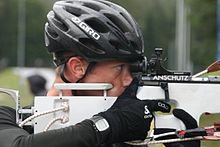JG Anschütz
| JG Anschütz GmbH & Co. KG
|
|
|---|---|
| legal form | GmbH & Co. KG |
| founding | 1856 re-establishment in 1950 |
| Seat | Ulm , Germany |
| management | Jochen Anschütz |
| Number of employees | 91 |
| Branch | Weapons manufacturer |
| Website | www.anschuetz-sport.com |
| As of December 31, 2018 | |
The JG Anschütz GmbH & Co. KG is an in Ulm -based weapons manufacturer , the hunting and sporting weapons developed and produced.
overview
Originally from Zella-Mehlis , it is one of the arms manufacturers that successfully continued its production in Ulm after the Second World War . Today the company is managed by Jochen Anschütz. It has around 100 employees and is active both nationally and internationally. The export share is over 60%. The name Anschütz enjoys a worldwide reputation especially in biathlon sport, where over 97% of all biathletes worldwide use this sports equipment.
history
Julius Gottfried Anschütz, son of a gunsmith from the former Mehlis weapons center (now Zella-Mehlis ), founded the JG Anschütz weapons factory there in 1856, a company that specialized in the production of pocket pistols and special rifles and their repairs. In 1896 the company with over 70 employees moved into a new and own factory site in Mehlis, alongside other weapons manufacturers known today and then such as Carl Walther, Friedrich Langenhahn and Herrmann Weihrauch.
After the death of the company's founder Julius Gottfried, the sons Fritz and Otto Anschütz took over the company and expanded it over the next decades. At the beginning of the war year 1914, over 200 people were working in the factory. With Max and Rudolf Anschütz, Fritz's sons, the third generation took over the family business with around 580 employees after the deaths of Otto (1923) and Fritz (1935). Dieter Anschütz was born on April 22, 1930, Max's son and the successor to the traditional company seemed secure. But the Second World War changed the situation, and during the war the company only produced armaments , including the use of slave labor . At the end of the war, Anschütz was therefore expropriated and the factory dismantled.
After the Anschütz family had been resettled and expropriated after the Second World War, they rebuilt the company in Ulm in 1950. In 1953, Anschütz benefited from the new legal regulation that hunters were again allowed to own weapons. The company also immediately entered the new market for air guns. In 1954, the Match-54 small bore system, now famous among riflemen, was developed, which is still used in Anschütz small-caliber weapons to this day. There were soon sporting successes on an international level. For example, at the 1960 Olympic Games in Rome, 50% of the small-bore shooters competed with Anschütz weapons and won 4 medals. In 1966 Gerd Kümmet became the first ever world air rifle champion with a modified Anschütz LG 220 . The management of the company remained a family matter. Max Anschütz handed the management over to his son Dieter in 1968.
At the end of the 1970s, Dieter Anschütz revolutionized biathlon in particular with the introduction of his small-bore rifle , in which he saw the future of sport. Until then, biathletes were still using large-caliber rifles, a holdover from the time when biathlon was a military sport. The new weapon was not only lighter, but also easier and, above all, faster to use. The breakthrough in the biathlon business came with the Fortner straight-pull fastener developed by Peter Fortner in 1984 and produced jointly with Anschütz . Since then, the company has enjoyed worldwide recognition, supported by numerous national and international successes in all areas of sport shooting. Nowadays over 90% of all biathletes shoot with Anschütz systems.
In 2001, 51% of the Steyr-Sportwaffen GmbH spun off from Steyr-Mannlicher was taken over. In 2008 Jochen Anschütz took over the management of the company, which today has 107 employees, which produces exclusively in Ulm and exports 60% of its weapons.
In addition to the traditional production of hunting and sporting weapons, investments are increasingly being made in new machining technologies. a. machining operations as a service for other companies.
literature
- John Walter: Rifles of the World . 3. Edition. Krause, 2006, ISBN 978-0-89689-241-5 , pp. 18-29 ( available ).
- Dieter Mutard: Anschütz. Gunsmith for centuries. Historic and modern sporting and hunting weapons . Motorbuch, Stuttgart 2006, ISBN 978-3-613-02687-2 (166 pages).
Web links
- www.anschuetz-sport.com
- Blue Book Publication: Anschütz company information (archive version)
Individual evidence
- ↑ Annual financial statements as of December 31, 2018 in the electronic Federal Gazette
Coordinates: 48 ° 22 '10.4 " N , 9 ° 57' 12.3" E


